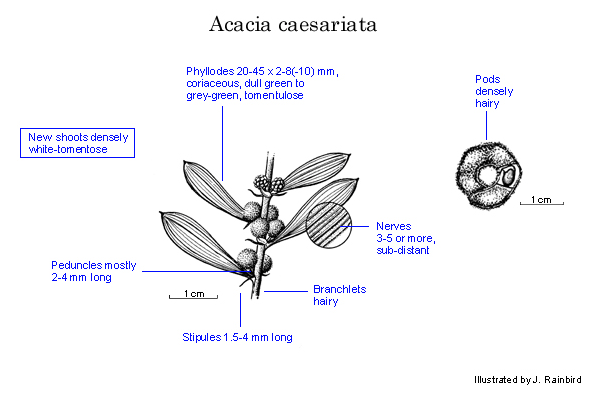Acacia caesariata R.S.Cowan & Maslin
WATTLE
Acacias of Australia
Family
Fabaceae
Distribution
Scattered from near Kununoppin S to Lake Grace, south-western W.A.
Description
Shrub 0.6–1.3 m high, dense, spreading, rounded or flat-topped. New shoots conspicuous by a dense white tomentum. Branchlets slightly ribbed, tomentose. Stipules persistent, subulate, 1.5–4 mm long. Phyllodes ascending to erect, oblanceolate to linear oblanceolate, straight to shallowly incurved, 2–4.5 cm long, 2–8 (–10) mm wide, rounded-obtuse to acute, mucronate, coriaceous, dull green to grey-green, tomentose, tardily glabrescent, with 3–5 or more subdistant longitudinal nerves per face, sometimes with occasional anastomoses; gland 0–3 mm above pulvinus. Inflorescences simple, 2 per axil; peduncles mostly 2–4 mm long, tomentose; heads globular, 4 mm diam., 18–20-flowered, light golden; bracteoles linear-fusiform to narrowly oblong. Flowers 5-merous; sepals free; petals glabrous. Pods irregularly curved, undulate or coiled, to 2.5 cm long, 2–3 mm wide, chartaceous, densely pubescent. Seeds longitudinal, oval, elliptic or oblong, 2.5–3 mm long, glossy, black; aril large, terminal, helmet-shaped, white.
Habitat
Found mostly in mallee scrub and eucalypt woodland, in hard loam or clay.
Specimens
W.A.: Corrigin, J.Goodwin K22 (PERTH); 11.5 km N of Bungulla towards Wyalkatchem, B.R.Maslin 3399 (AD, BRI, CANB, G, K, MEL, NSW, PERTH); between Lake Grace and Kulin, N.Perry 518 (PERTH).
Notes
Further study is need to better understand the patterns of variation of phyllodes within this species. Specimens from the Kununoppin–Wyalkatchem area have the broadest phyllodes (4–8 mm wide); elsewhere the phyllodes are 2–3 mm wide. The narrow phyllode individuals are easily confused with A. sclerophylla var. pilosa (which has phyllodes 1–2 mm wide) but are most readily distinguished by their densely tomentose new shoots (hairs ±appressed) and longer stipules (1.5–2 mm long); in A. sclerophylla var. pilosa the hairs on new shoots are not as dense and are rather wide-spreading, and the stipules are 0.5–1 mm long.
Most closely related to A. torticarpa. There is a superficial similarity to A. consobrina but phyllodes of that species have numerous anastomoses between the primary nerves, in addition to other differences. Also similar in appearance to A. sclerophylla var. pilosa (see above).
FOA Reference
Data derived from Flora of Australia Volumes 11A (2001), 11B (2001) and 12 (1998), products of ABRS, ©Commonwealth of Australia
Author
R.S.Cowan
This identification key and fact sheets are available as a mobile application:
URL: https://apps.lucidcentral.org/wattle/
© Copyright 2018. All rights reserved.









